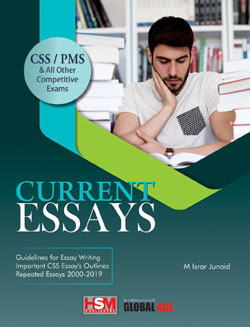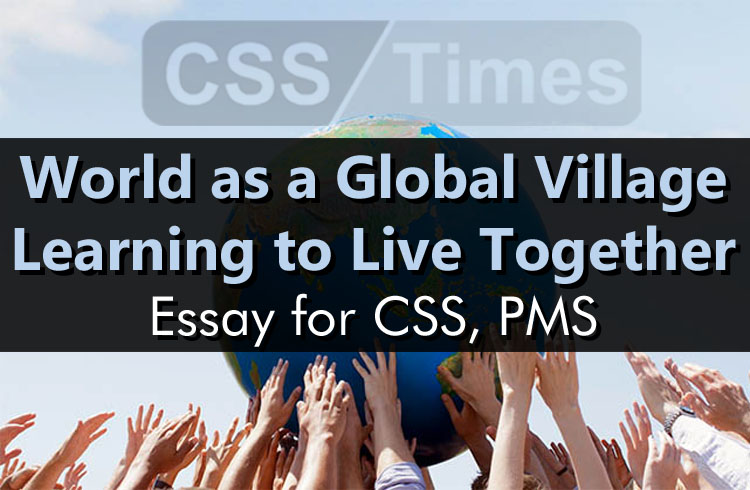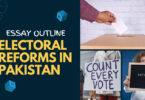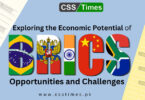World as a Global Village: Learning to Live Together | CSS Essay Outline
1. Introduction
Globalization has led to the economic, political and socio-cultural integration making the world a global village. The prospects of learning to live together are, however, still evolving amid the hurdles persisting to check its course.
2. Aspects of Global Village
Globalization of economy
Global integration of politics
Global village of socio-cultural integration
3. Contemporary Manifestations of ‘Learning to Live Together in Global Village’
Internet and its global use
International Political Community
Global Economic Organizations
4. World Learning to Live Together
The case study of Iran and P5+1 Nuclear Deal
The Melting of Ice between Cuba and the US
The traditional rivals of South Asia and the efforts to live together
5. Hurdles in the Learning of Global Village to Live Together
Criticism on globalization as a threat to national interests
Gap between the Global North and the Global South
Economic, literary, cultural and technological backwardness
Clash of Interests
Clash of Civilizations
Weak international institutions
6. Ways to Learn to Live Together
Strengthening the global institutions
Minimizing the ideological difference between civilizations
Pursuing mutual interests and fighting common threats
Liberalism of trade
Dialogue to be the first choice of conflict resolution
7. Conclusion
World as a Global Village: Learning to Live Together | CSS Essay
The term global village was coined by Marshall McLuhan, a Canadian philosopher and a public intellectual, in the beginning of the 1960s. He had a vision of technology reducing the size of the globe to that of a village, with information floating freely and simultaneously from one end to the other. McLuhan believed that interconnectivity on such a scale had the ability to heighten human awareness and bring together all political and social functions.
World is called a global village by the virtue of globalization which is a multi-faceted process. Globalization is integration of everything. It can be integration of political, cultural and technological prospects. The most apparent manifestation of globalization is economic and political integration. Similarly, the globalization which plays major role in making the world a global village comes in shape of technological integration.
Global village is attributed with sharing information, products, investments and profits. In political terms global village is featured by presence of an evolved international community at the platform of the UN. The growth of an integrated village brings several benefits to the masses as well as states along with causing trouble for the national interests.
Considering the dimensions of global village, the economic integration has brought the world closer and dependable on each other. Multinational companies, global economic forums and cross-border investments; all play vital role in making the world a global village.
For many, globalization is equated with economic interdependence. At the dawn of the 21st century, the scale and magnitude of global economic interaction appears to be unprecedented The volume of capital flows far exceeds that of the past. The developing world, too, have increasingly become a part of global trade and capital flows Contemporary patterns of economic globalization suggest the emergence of a new international division of labor In short, the world has reached a stage in which one can meaningfully refer to one global economy.
Political integration of the world states which helps to unite global village becomes obvious at the platform of the United Nations. This institution has 193 member states which discuss and decide upon all the important political events of international prospects. International political security, regional and global alliances against terrorism, international treaties on nuclear non-proliferation; all reveal the political integration of the global village.
Another important aspect of global village is socio-cultural integration. It is the mixing of cultural values and customs to evolve the new ones. Apparent manifestation of socio-cultural integration in the global village comes in the shape of fashion, traditions and practices one adopts after getting inspired by another culture through books and movies most of the times.
These all aspects of globalization render the global village to learn to live together. This becomes possible when the world states interact and find mutual interests. Those interests might be political, economic or social.
Multinational organizations and global institutions represent another manifestation of how the world is learning to live together. European Union, for example, represents togetherness of the European nations. Similarly, ASEAN is the association of South East Asian nations for attaining definite economic goals. In South Asia SAARC emerges to be an organization for regional cooperation. IMF and the World Bank bring the world closer in monetary aspects. Muslim states of the world form OIC as their distinct body. NATO is a military alliance of European and American nations. Thus, in all ways, world states practice the art of living together for the obvious reasons.
Recently two important developments in the global political context occurred that reflect how the nations are learning to live together. First came the nuclear deal between Iran and P5+1. Iran and the US had been at daggers drawn since the Iranian Revolution of 1979. The country also went to develop nuclear weapons secretly unless came to the knowledge of international community. This led to the beginning of talks between Iran and the Permanent Five members of the UN Security Council along with Germany.
The deals bore positive results after years of negotiations. This proves how the global states are learning to live together in the global village. Today, Iran is back in the mainstream international transactions. The danger to the global village has been averted.
Second case comes from the continents of America. The United States and the Latin American state of Cuba remained in rift since 1959 when Cuba was revolutionized by the forces of Fidel Castro. The Castro government was unfavorable to the US throughout the years of the Cold War. The US has for long imposed embargo on the island state of Cuba. The ice however melted previous year when the Pope visited both the countries helping them to normalize relations. This visit was followed by initiating diplomatic relations between both the countries after more than 70 years. This case also reveals the willingness and practice of the world to live together in the global village.
Third case study can be made on the South Asian states of India and Pakistan. Both the countries have several territorial disputes along with ideological and historical differences. They have fought two full-scale wars and a number of other skirmishes. But both find no solution in offensive methods. Comprehensive dialogue between both the states has been revived recently which reflects that they are learning to live together as peaceful neighbors though it’s tough.
Living together in the global village brings fruits of harmony, peace, trade and unity. But at the same time smaller states becomes victim of the evils of globalization. For example, World Trade Organization aims at lowering the trade tariffs across the globe. This brings free trade for the global village but not the fair trade. Developing states find it difficult to lower the tariffs on the limited products they export to earn revenue.
Along with this major hurdle there are several other obstacles in the learning of global village to live together. One major hurdle is clash of interests and priorities. Not all the world states prioritize the same things on their respective national agendas. Some times in the wake of global village’s mantra the national interests of the states are at stake. This declines confidence of those states on the virtues of global village.
Clash of civilizations is another theory which undermines the art of learning to live together. The theory given by Huntington speaks for the grounds of clash between the world states in the future would be cultural. This puts stones in the way of global integration.
Further the structural flaws in the international institutions which help in strengthening the hegemony of a few powerful states also impede the process of learning to live together. In order to ensure better working of global village international institutions are to be strengthened ending all the undue influence upon them.
People need to find the common goals and mutual interests in order to learn the art of living together in the global village. States need to collectively fight the common threats at the same time. Preference of liberalism over realism can be more beneficial in achieving this goal.
In compact, nations depend on each other. This level of dependence when reaches its peak, the world begins to become a global village. Hurdles in the way of globalization persists amid the efforts of international community to unite on the points of mutual interests.
Thriving institutions and corporations recognize the benefits of a diverse workforce and acknowledge how communication and technological advancements foster creativity within the team. Every culture contributes its own insight into an issue, introducing new ideas, awakening inspiration and driving success.
Don’t be afraid of differences or change! Make technology your friend, remain mindful of your environment, and recognize the endless benefits of our multicultural society to foster business success within the Village.
Book Source:

CSS Current Essays
Book Price: 495
Whatsapp your order at 03000459551 to get book at your doorstep with cash on delivery
Check our Collection of English Essays specially for CSS
- Essay Outline: Electoral Reforms in Pakistan: Necessity and Challenges
- Health for All | Essay Outline for CSS PMS
- Exploring the Economic Potential of BRICS Countries: Opportunities and Challenges
- Art and Morality Essay Outline
- Instruction in Youth is Like Engraving in Stone | Complete Essay with Outline
- Public Office is a Public Trust | Complete CSS Essay
- Essay Outline “Good Governance is deeply rooted in Human Development”
- CSS Essay Outline | The Importance of Water Conservation and Management
- How to Write Effective Essay for CSS Exams
- How to Write Effective Essay on Economy? 7 Steps







